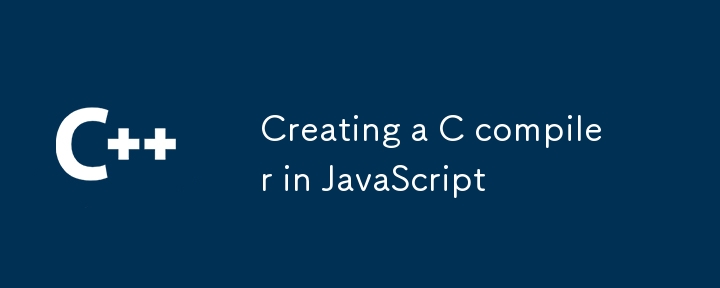JavaScript에서 C 컴파일러 만들기
- PHPz원래의
- 2024-07-18 01:42:311268검색

JavaScript에서 C 컴파일러를 만드는 것은 어휘 분석, 구문 분석, 의미 분석, 코드 생성을 비롯한 여러 구성 요소가 포함되는 복잡하고 야심찬 프로젝트입니다. 다음은 이러한 컴파일러 구축을 시작하는 방법에 대한 간단하고 높은 수준의 예입니다. 이 예제에서는 C 코드 컴파일의 첫 번째 단계인 어휘 분석(토큰화) 및 구문 분석 단계에 중점을 둡니다.
1단계: 어휘 분석(토큰화)
어휘 분석기(렉서)는 입력 C 코드를 토큰 스트림으로 변환합니다.
class Lexer {
constructor(input) {
this.input = input;
this.tokens = [];
this.current = 0;
}
tokenize() {
while (this.current < this.input.length) {
let char = this.input[this.current];
if (/\s/.test(char)) {
this.current++;
continue;
}
if (/[a-zA-Z_]/.test(char)) {
let start = this.current;
while (/[a-zA-Z0-9_]/.test(this.input[this.current])) {
this.current++;
}
this.tokens.push({ type: 'IDENTIFIER', value: this.input.slice(start, this.current) });
continue;
}
if (/[0-9]/.test(char)) {
let start = this.current;
while (/[0-9]/.test(this.input[this.current])) {
this.current++;
}
this.tokens.push({ type: 'NUMBER', value: this.input.slice(start, this.current) });
continue;
}
switch (char) {
case '+':
this.tokens.push({ type: 'PLUS', value: '+' });
this.current++;
break;
case '-':
this.tokens.push({ type: 'MINUS', value: '-' });
this.current++;
break;
case '*':
this.tokens.push({ type: 'STAR', value: '*' });
this.current++;
break;
case '/':
this.tokens.push({ type: 'SLASH', value: '/' });
this.current++;
break;
case '=':
this.tokens.push({ type: 'EQUAL', value: '=' });
this.current++;
break;
case ';':
this.tokens.push({ type: 'SEMICOLON', value: ';' });
this.current++;
break;
case '(':
this.tokens.push({ type: 'LPAREN', value: '(' });
this.current++;
break;
case ')':
this.tokens.push({ type: 'RPAREN', value: ')' });
this.current++;
break;
default:
throw new TypeError('Unexpected character: ' + char);
}
}
return this.tokens;
}
}
2단계: 구문 분석
파서는 토큰 스트림을 추상 구문 트리(AST)로 변환합니다.
class Parser {
constructor(tokens) {
this.tokens = tokens;
this.current = 0;
}
parse() {
let ast = {
type: 'Program',
body: []
};
while (this.current < this.tokens.length) {
ast.body.push(this.parseStatement());
}
return ast;
}
parseStatement() {
let token = this.tokens[this.current];
if (token.type === 'IDENTIFIER' && this.tokens[this.current + 1].type === 'EQUAL') {
return this.parseAssignment();
}
throw new TypeError('Unknown statement: ' + token.type);
}
parseAssignment() {
let identifier = this.tokens[this.current];
this.current++; // skip identifier
this.current++; // skip equal sign
let value = this.parseExpression();
this.expect('SEMICOLON');
return {
type: 'Assignment',
identifier: identifier.value,
value: value
};
}
parseExpression() {
let token = this.tokens[this.current];
if (token.type === 'NUMBER') {
this.current++;
return {
type: 'Literal',
value: Number(token.value)
};
}
throw new TypeError('Unknown expression: ' + token.type);
}
expect(type) {
let token = this.tokens[this.current];
if (token.type !== type) {
throw new TypeError('Expected ' + type + ' but found ' + token.type);
}
this.current++;
}
}
3단계: 코드 생성
마지막으로 코드 생성기는 AST를 대상 언어(JavaScript 또는 다른 언어일 수 있음)로 변환합니다.
class CodeGenerator {
generate(node) {
switch (node.type) {
case 'Program':
return node.body.map(statement => this.generate(statement)).join('\n');
case 'Assignment':
return `let ${node.identifier} = ${this.generate(node.value)};`;
case 'Literal':
return node.value;
default:
throw new TypeError('Unknown node type: ' + node.type);
}
}
}
모든 것을 하나로 합치기
어휘 분석기, 파서 및 코드 생성기를 사용하는 방법은 다음과 같습니다.
const input = `x = 42;`;
const lexer = new Lexer(input);
const tokens = lexer.tokenize();
console.log('Tokens:', tokens);
const parser = new Parser(tokens);
const ast = parser.parse();
console.log('AST:', JSON.stringify(ast, null, 2));
const generator = new CodeGenerator();
const output = generator.generate(ast);
console.log('Output:', output);
이렇게 하면 입력이 토큰화되어 AST로 구문 분석되고 AST에서 JavaScript 코드가 생성됩니다.
메모
이 예는 매우 단순화되었으며 C 언어의 작은 하위 집합만 처리합니다. 완전한 C 컴파일러를 사용하려면 훨씬 더 큰 토큰 세트를 처리하고, 복잡한 표현식, 명령문, 선언, 유형을 구문 분석하고, 더욱 정교한 코드를 생성해야 합니다.
위 내용은 JavaScript에서 C 컴파일러 만들기의 상세 내용입니다. 자세한 내용은 PHP 중국어 웹사이트의 기타 관련 기사를 참조하세요!
성명:
본 글의 내용은 네티즌들의 자발적인 기여로 작성되었으며, 저작권은 원저작자에게 있습니다. 본 사이트는 이에 상응하는 법적 책임을 지지 않습니다. 표절이나 침해가 의심되는 콘텐츠를 발견한 경우 admin@php.cn으로 문의하세요.

